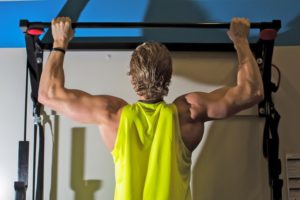Often when we’re exercising we like to focus on muscle groups that we can see, such as the chest, biceps, abs, and quads – you know the “beach muscles”. But what about the muscles we can’t see — the posterior (back) side? More often than not we tend to neglect the posterior side (back/butt/hamstrings/calves) of our body because we can’t see those muscles in the mirror. Neglecting one or more of these muscles not only causes weakness on the backside of the body, but significant tightness on the front side of the body. This can lead to substantial orthopedic issues in the shoulders, lower back, and knees if not corrected.
The Problem:
When progressive muscle weakening occurs on the posterior side of the body, progressive muscle tightening occurs on the front side of the body. How does this happen? When muscles become weak, they elongate (beyond their natural resting length), this weakness is in part due to reduced nervous system signals sent to the muscle. At the same time that a reduced nerve signal is sent to these posterior muscles, a greater signal is sent to the opposite muscles on the front of the body (i.e., weak upper back means tighter chest muscles). This process occurs during the course of our daily lives, such as driving or computer posture, where most people are hunched over. This exacerbates posterior weakness and anterior tightness, which can affect your posture, gait, and activity of daily living if left unchecked.
What You Can Do:
Balance your workout so you’re engaging both sides of the body not just what you can see. Exercises that engage your posterior include pulling movements such as rows/ lat pull down, superman, stability ball leg curls/ bridges, and pelvic lifts. Also, make sure to stretch; over time it’ll become tight from constantly activating/working.
Below is an intermediate posterior workout:
|
Posterior workout |
|||
|
Exercise |
Sets |
Reps |
Rest Interval (s) |
|
Lat pulldown |
3 |
12 to 15 |
90 |
|
Stability ball leg curl |
3 |
12 to 15 |
90 |
|
Cable seated row |
2 |
12 to 15 |
75 |
|
Stability ball bridge |
2 |
12 to 15 |
75 |
|
Calf raise |
2 |
12 to 15 |
75 |
|
Plank |
3 |
30-60sec |
60 |
|
Pelvic lift |
3 |
12 to 15 |
60 |
Take Home Message:
We all have our own specific fitness goal –bigger arms, smaller waist, better abs — but just remember that there are two sides of the coin. Working your back as well as your front will help in overall body balance, eliminate weaknesses, and prevent overuse injuries in our daily activities, such as posture and gait.
About the Author:
-

Michael Stack is the founder & CEO of Applied Fitness Solutions and Frontline Fitness Pros. He is a faculty lecturer for the University of Michigan’s School of Kinesiology. He is also the creator and the host of the Wellness Paradox Podcast, produced in conjunction with University of Michigan.
Michael is an exercise physiologist by training and a health entrepreneur, health educator, and fitness industry advocate by trade. He is dedicated to enhancing the standard of practice of, and advocating for, fitness and wellness professionals to ensure they become an essential constituent in the healthcare delivery system.
With a career spanning over three decades in fitness, health, and wellness Michael has a deep knowledge of exercise physiology, health/wellness coaching, lifestyle interventions to mitigate chronic disease and leadership. He is credentialed through the American College of Sports Medicine (ACSM) as an Exercise Physiologist (ACSM-EP), Exercise is Medicine practitioner (ASCM-EIM), and a Physical Activity in Public Health Specialist (ACSM-PAPHS). Michael is a National Strength & Conditioning Association (NSCA) Certified Strength & Conditioning Specialist (CSCS), and a CDC Diabetes Prevention Program (DPP) Lifestyle Coach.
Michael received his undergraduate degree from the University of Michigan’s School of Kinesiology in 2004 and is currently a Master’s of Public Health (MPH) candidate at University of Michigan, with a specific concentration in health behavior and health education.
Michael is a board of directors’ member for the Physical Activity Alliance and Michigan Fitness Clubs Association. He sits on the University of Michigan’s School of Kinesiology Alumni Board of Governors. Michael is an expert curriculum reviewer for the American College of Lifestyle Medicine. Finally, he is a member of the executive leadership team for American Heart Association’s Heart Walk.
Michael lectures nationally for several health/fitness certification and continuing educations, including; IHRSA, the Medical Fitness Association, the National Strength & Conditioning Association, and SCW Fitness.

